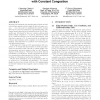Free Online Productivity Tools
i2Speak
i2Symbol
i2OCR
iTex2Img
iWeb2Print
iWeb2Shot
i2Type
iPdf2Split
iPdf2Merge
i2Bopomofo
i2Arabic
i2Style
i2Image
i2PDF
iLatex2Rtf
Sci2ools
STOC
2006
ACM
2006
ACM
Edge-disjoint paths in Planar graphs with constant congestion
We study the maximum edge-disjoint paths problem in undirected planar graphs: given a graph G and node pairs s1t1, s2t2, . . ., sktk, the goal is to maximize the number of pairs that can be connected (routed) by edge-disjoint paths. The natural multicommodity flow relaxation has an ( n) integrality gap. Motivated by this, we consider solutions with small constant congestion c > 1; that is, solutions in which up to c paths are allowed to use an edge (alternatively, each edge has a capacity of c). In previous work we obtained an O(log n) approximation with congestion 2 via the flow relaxation. This was based on a method of decomposing into well-linked subproblems. In this paper we obtain an O(1) approximation with congestion 4. To obtain this improvement we develop an alternative decomposition that is specific to planar graphs. The decomposition produces instances that we call OkamuraSeymour (OS) instances. These have the property that all terminals lie on a single face. Another ing...
Algorithms | Multicommodity Flow Relaxation | Planar Graphs | STOC 2006 | Undirected Planar Graphs |
| Added | 03 Dec 2009 |
| Updated | 03 Dec 2009 |
| Type | Conference |
| Year | 2006 |
| Where | STOC |
| Authors | Chandra Chekuri, Sanjeev Khanna, F. Bruce Shepherd |
Comments (0)

